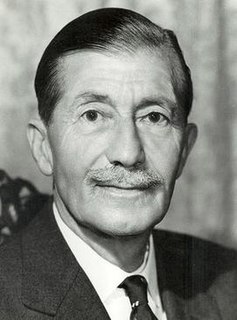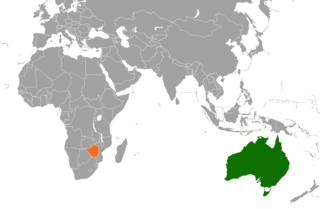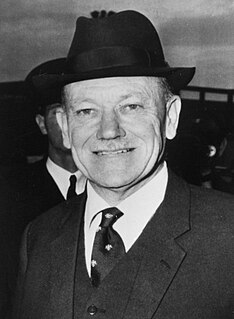
Ian Douglas Smith was a Rhodesian politician, farmer, and fighter pilot who served as Prime Minister of Rhodesia from 1964 to 1979. He was the country's first premier not born abroad, and led the predominantly white government that unilaterally declared independence from the United Kingdom in November 1965, following prolonged dispute over the terms. He remained Prime Minister for almost all of the 14 years of international isolation that followed, and oversaw Rhodesia's security forces during most of the Bush War, which pitted the unrecognised administration against communist-backed black nationalist guerrilla groups. Smith, who has been described as personifying white Rhodesia, remains a highly controversial figure—supporters portray him as a man of integrity and vision "who understood the uncomfortable truths of Africa," while his opponents consider him "an unrepentant racist."

The University of Zimbabwe (UZ) is a public university in Harare, Zimbabwe. It opened in 1952 as the University College of Rhodesia and Nyasaland, and was initially affiliated with the University of London. It was later renamed the University of Rhodesia, and adopted its present name upon Zimbabwe's independence in 1980. UZ is the oldest and best ranked university in Zimbabwe.

The Prime Minister of Rhodesia was the head of government of Rhodesia. Rhodesia, which had become a self-governing colony of the United Kingdom in 1923, unilaterally declared independence on 11 November 1965, and was thereafter an unrecognized state until 1979. In December 1979, the country came under temporary British control, and in April 1980 the country gained recognized independence as Zimbabwe.

Clifford Walter Dupont, GCLM, ID was a British-born Rhodesian politician who served in the internationally unrecognised positions of Officer Administrating the Government and President. Born in London and qualifying as a solicitor, Dupont served during the Second World War as an officer of the British Royal Artillery in North Africa before first visiting Southern Rhodesia in 1947. He returned a year later, started a ranch and emigrated full-time during the early 1950s, by which time the country had become a territory of the Federation of Rhodesia and Nyasaland.

Sir Humphrey Vicary Gibbs,, was the penultimate Governor of the colony of Southern Rhodesia (1959–1969) who served through, and opposed, the Unilateral Declaration of Independence (UDI) in 1965.

Winston Joseph Field was a Rhodesian politician who served as the seventh Prime Minister of Southern Rhodesia. Field was a former Dominion Party MP who founded the Rhodesian Front political party with Ian Smith.

The Governor of Southern Rhodesia was the representative of the British Monarch in the self-governing colony of Southern Rhodesia from 1923 to 1980. The Governor was appointed by The Crown and acted as the local head of state, receiving instructions from the British Government.
Ken Flower was a Rhodesian police officer in Southern Rhodesia. He was born in Cornwall, England. After war service in British Somaliland and Ethiopia he returned to Rhodesia in 1948 rapidly rising in the hierarchy of the BSAP. He studied the Mau Mau insurgency in Kenya and applied his knowledge in the disturbances in British Nyasaland during the late 1950s.
Iain Peter Butchart, a cricketer, was born in Bulawayo on 9 May 1960. Broadcasting of television started in November. The Zimbabwe African People's Union (ZAPU) was formed in 1961 with Joshua Nkomo as leader. The Rhodesian Front won the general elections of 1962 on 14 December. Winston Field then became the Prime Minister of Rhodesia. The Zimbabwe African National Union (ZANU) was formed in 1963 with Robert Mugabe as Secretary. The Federation of Rhodesia and Nyasaland was dissolved on 31 December 1963 as Zambia and Malawi moved towards independence. The government placed Joshua Nkomo, leader and founder of the Zimbabwe African Peoples Union, under restriction on 16 April 1964. Northern Rhodesia gained its independence and Southern Rhodesia became the colony of Rhodesia on 24 October.

Australia–Zimbabwe relations are foreign relations between Australia and Zimbabwe. Both countries have full embassy level diplomatic relations. Australia currently maintains an embassy in Harare, and Zimbabwe maintains an embassy in Canberra.

Zimbabwe and the Commonwealth of Nations have had a controversial and stormy diplomatic relationship. Zimbabwe is a former member of the Commonwealth, having withdrawn in 2003, and the issue of Zimbabwe has repeatedly taken centre stage in the Commonwealth, both since Zimbabwe's independence and as part of the British Empire.

The history of the Jews in Zimbabwe reaches back over one century. Present-day Zimbabwe was formerly known as Southern Rhodesia and later as Rhodesia.

The President of Rhodesia was the head of state of Rhodesia from 1970 to 1979. As Rhodesia reckoned itself as a parliamentary republic rather than a presidential republic at the time, the president's post was almost entirely ceremonial, and the real power continued to be vested in Rhodesia's Prime Minister, Ian Smith. Two individuals held the office of president, while two others served as acting Presidents. All were white people of British descent.

The modern political history of Zimbabwe starts with the arrival of white people to what was dubbed Southern Rhodesia in the 1890s. The country was initially run by an administrator appointed by the British South Africa Company. The prime ministerial role was first created in October 1923, when the country achieved responsible government, with Sir Charles Coghlan as its first Premier. The third Premier, George Mitchell, renamed the post Prime Minister in 1933.

Sir Thomas Hugh William Beadle was a Rhodesian lawyer, politician and judge who served as Chief Justice of Southern Rhodesia from March 1961 to November 1965, and as Chief Justice of Rhodesia from November 1965 until April 1977. He came to international prominence against the backdrop of Rhodesia's Unilateral Declaration of Independence (UDI) from Britain in November 1965, upon which he initially stood by the British Governor Sir Humphrey Gibbs as an adviser; he then provoked acrimony in British government circles by declaring Ian Smith's post-UDI administration legal in 1968.
Michael Theodore Hayes Auret was a Zimbabwean farmer, politician, and activist. A devout Catholic, he served as chairman and later director of the Catholic Commission for Justice and Peace in Zimbabwe (CCJP) from 1978 until 1999. He also served as a member of Parliament for Harare Central from 2000 to 2003, when he resigned and emigrated to Ireland.
Zimbabwe Newspapers (1980) Limited, operating as Zimpapers, is a state-controlled Zimbabwean mass media company. Originally a newspaper Publishing company, in the 2010s it expanded its operations to include commercial printing, radio and television. The company's portfolio includes over a dozen Magazines and newspapers, including The Herald and The Chronicle, several radio stations, and a television network. It is the largest newspaper publisher in Zimbabwe.
Zimbabwe House, formerly called Independence House and Dzimbahwe, is an official residence of the President of Zimbabwe in Harare, Zimbabwe. It was built in 1910 as was used as the house of the Prime Minister of Southern Rhodesia, Prime Minister of Rhodesia, Prime Minister of Zimbabwe Rhodesia and Prime Minister of Zimbabwe.

State House, formerly called Government House, is a former Government House in Bulawayo, Zimbabwe. It was used by the British South Africa Company during their rule in Rhodesia. It was built by Cecil Rhodes in 1897 as his personal residence. It is now used as the official Bulawayo residence for the President of Zimbabwe.














